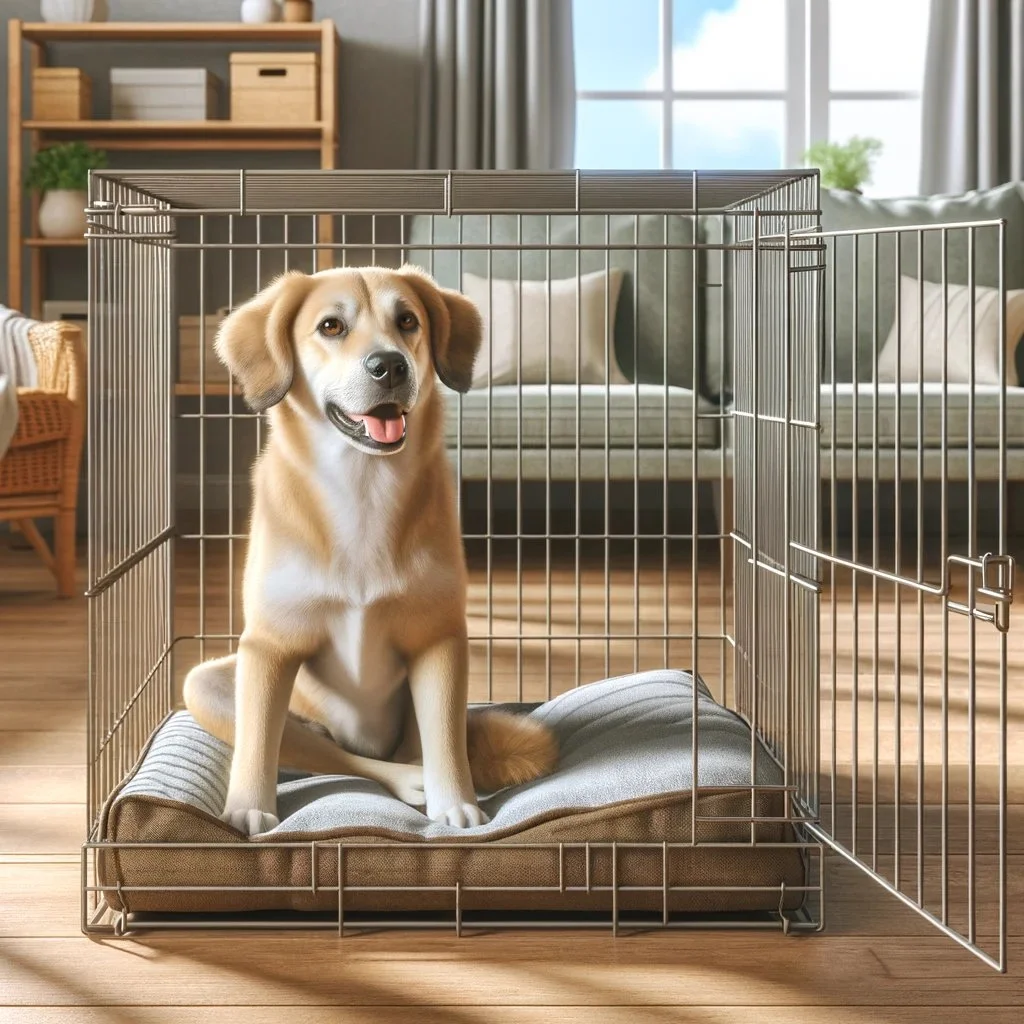Crate Training
When people discuss crate training, they often think it’s not for them, they know it’s something they should try, or they tried it once and it didn’t work out. Some may also have misconceptions about what it is and why they would find it beneficial. Crate training is not forcing your dog into the crate and then leaving them there for hours at a time. This actually does much more harm than good, both psychologically and physically. It is also traumatizing to you, the owner.
Instead, crate training should be approached as mutually beneficial to you and your dog and provides your dog a safe space.
Humans need a place to separate themselves from others when we get stressed, frustrated, or tired. Your dog is the same. By providing them a space that is theirs, they are better able to regulate behaviors and manage stressful situations. Make sure the crate is filled with a comfortable bed, toys, and the door left open so they can enter and exit freely while you are home; this helps make it a much more comfortable place for them to be.
Crate training also benefits you when you need to transport them to the vet, or keep them overnight somewhere. This gives them a place to physically protect them during transportation, and helps to cope when stressed.
You should also be aware:
If your puppy is under six months old, they should not be crated for longer than three hours, because they need to get out their energy and go potty outside. Leaving them in a crate for longer can condition them to resent the environment.
Never use the crate as punishment. Again, we are trying to make this a safe, happy place for them. Putting them in a crate as punishment goes against that process and prolong the crate training process.
Crate your dog until they are able to be alone in the house without accidents or destructive habits. You can graduate your dog from a crate to an enclosed area of your home, like your kitchen, before giving them access to the full house when you’re away. The crate should always have a comfortable bed, and the door left open, when you’re home, so your dog can enter it when they need a safe space.
A dog in the crate too long may not be properly socialized or getting enough exercise, which can develop into anxiety and depression. If you find you are needing to leave your dog in the crate for extended periods of time, hire a pet sitter or dog walker to come over one or two times throughout the day to interact with them and provide exercise.
What are some basic steps to crate training?
The crate should be large enough for them to stand up and turn around in. If your dog is still growing, choose a crate size that will accommodate their adult size. Block off the excess crate space so your dog can't eliminate at one end and retreat to the other.
Crate training can take days or weeks, depending on your dog's age, temperament and past experiences. It's important to keep two things in mind: The crate should always be associated with something pleasant and training should take place in a series of small steps. Don't go too fast.
Step 1: Introduction to crate
Put the crate in a place where you and your family spend a lot of time.
Take off the door to the crate and put a soft bed, blanket, or towel inside.
Allow your dog to freely explore at their leisure.
If they are hesitant to enter or approach, try tossing their favorite treat or toy into it. Remember to never force them to enter all of the way. Continue to praise them no matter how far or how little they enter into the crate.
Continue to encourage them to enter until they enter on their own accord.
Step 2: Feeding in crate
Feeding in the crate for regular meals creates a positive and pleasant association.
Start by placing the food bowl at the far back corner of the crate. If they refuse to enter, bring the bowl all the way to the front and allow them to eat there.
With each successive feeding, push the bowl further and further back until you are able to close the door while they eat.
Open the door immediately when they are done eating and give them a treat.
Slowly build up the time between when they finish eating and when you open the door until you make it to 10 minutes. Remember to always reward and give lots of praise.
It is at this stage where many will give up. If your dog whines and cries while in the crate at this time, do not let them out until they have stopped. If you let them out when they cry, you are training them to cry and they will be let out, an association you do not want. If the whining continues after you've ignored them for several minutes, use the phrase they associate with going outside to eliminate. If they respond and become excited, take them outside. This should be a trip with a purpose, not play time. If you're convinced your dog doesn't need to eliminate, the best response is to ignore them until they stop whining. Don't give in; if you do, you'll teach your dog to whine loud and long to get what they want. If you've progressed gradually through the training steps and haven't done too much too fast, you'll be less likely to encounter this problem. If the problem becomes unmanageable, you may need to start the crate training process over again.
Step 3: Crate for longer periods and build up to while you’re away
Continue feeding regular meals in the crate, and building up the time they spend in there.
Add time incrementally, so your dog builds a better association with the crate gradually. You do not want to suddenly add three or four hours when they were only used to 30 minutes.
At this stage, you are putting the dog in during times other than feeding. By calling them over, giving a command such as “enter“ or “bed”, and then rewarding with a treat when they enter.
Once your dog can spend 30 minutes in the crate without whining or anxiety, you are ready to put them in the crate when you leave.
Create a "getting ready to leave" routine so your dog can associate you making coffee with you leaving the house. Although they shouldn't be crated for a long time before you leave, you can crate them anywhere from five to 20 minutes prior to leaving.
Don't make your departures emotional and prolonged—they should be matter-of-fact. Praise your dog briefly, give them a treat for entering the crate, and then leave quietly.
When you return home, don't reward your dog for excited behavior by responding to them in an enthusiastic way. Keep arrivals low-key to avoid increasing their anxiety over when you will return. Continue to crate your dog for short periods from time to time when you're home, so they don't associate crating with being left alone.
If you are looking for help with the crate training process, we have also written another blog of local dog trainers in the Sedalia area. Additionally, we are happy to help with the process, and provide midday breaks and exercise for those dogs needing to get out their energy while you are away.

